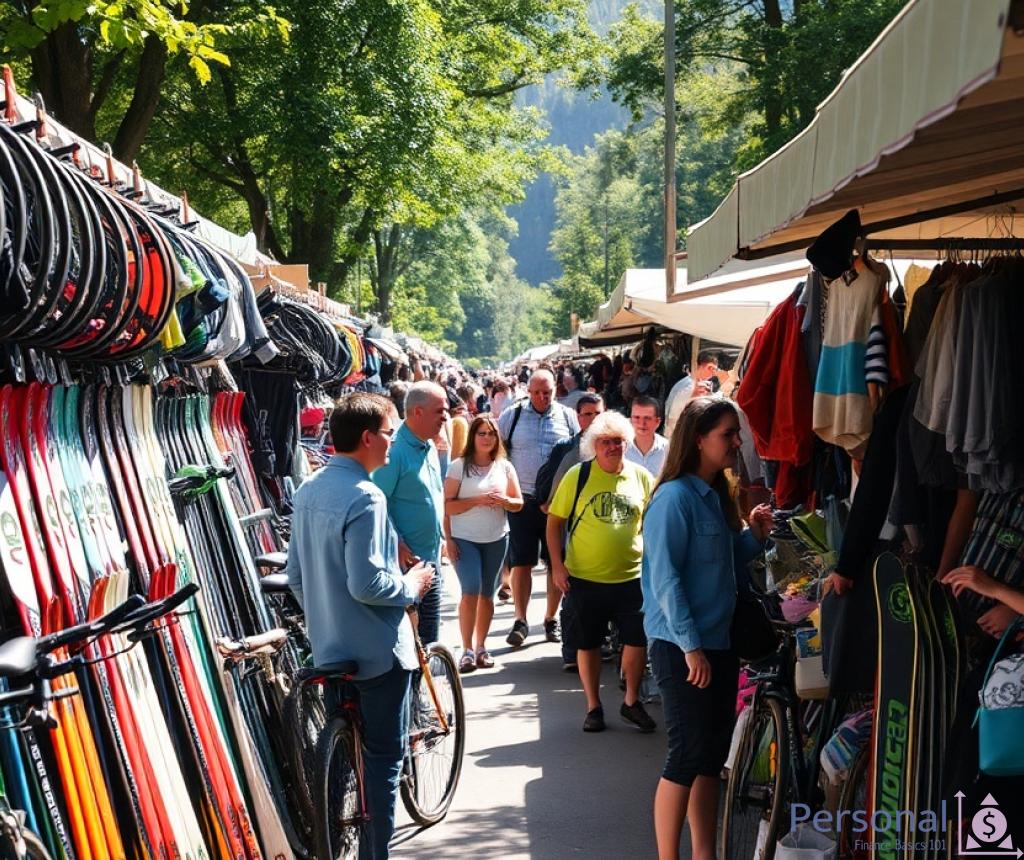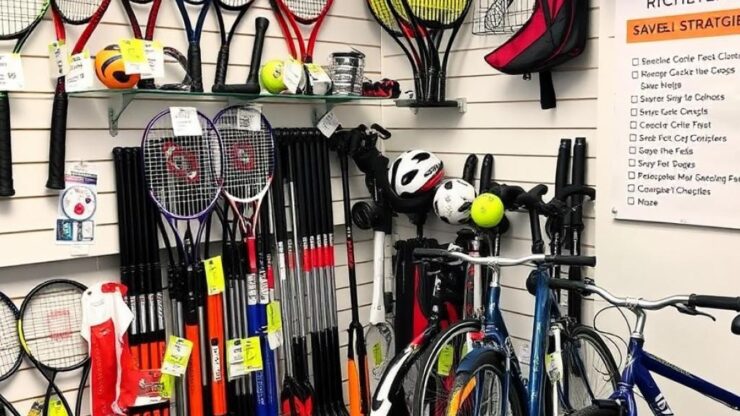Utilizing Seasonal Sales for Maximum Savings
When it comes to purchasing sports equipment, timing can significantly impact your budget. Recognizing the patterns of seasonal sales is crucial for maximizing your savings. Retailers often align their discounts with specific seasons, holidays, and sporting events, providing ample opportunities for savvy shoppers to capitalize on lower prices. By understanding when these sales typically occur, you can plan your purchases effectively and avoid paying full price.
Several key periods throughout the year present prime opportunities for scoring deals on sports equipment. Here’s a brief overview of these periods:
- End of Season Sales: Retailers often discount items as the season comes to a close to clear out inventory for new models.
- Black Friday and Cyber Monday: These two shopping events offer substantial discounts across various categories, including sports gear.
- Holiday Sales: Major holidays like Labor Day, Memorial Day, and Independence Day see retailers slashing prices on outdoor and sporting goods.
- Back-to-School Sales: For families with student athletes, this period often includes discounts on athletic gear.
In the digital age, numerous online tools can help you track and maximize your savings during seasonal sales. Utilizing price comparison websites and setting price alerts can ensure you never miss a great deal. Many retailers also offer loyalty programs and seasonal promotions that can further enhance your savings potential. Here’s how to leverage these tools:
- Price Comparison Tools: Websites and apps that compare prices across multiple retailers help you identify the best deals available.
- Price Alerts: Setting alerts for specific items can notify you when prices drop, allowing you to purchase at the right time.
- Loyalty Programs: Joining loyalty programs can provide you with exclusive discounts and early access to sales.
Exploring Secondhand Markets for Quality Gear

As the demand for sports equipment continues to rise, so does its price. However, a growing trend among budget-conscious athletes is to explore secondhand markets for quality gear. This approach not only allows you to save significantly but also promotes sustainability by giving pre-owned items a new lease on life. In this section, we will delve into the benefits of purchasing secondhand sports equipment and how to navigate these markets effectively.
Purchasing secondhand sports equipment comes with a plethora of advantages. Not only can you acquire high-quality items at a fraction of the original price, but the variety available can often exceed that of new items. Additionally, many sellers take great care of their gear, meaning you can find equipment that is barely used and in excellent condition. Below are some key benefits of buying secondhand:
- Cost Savings: Save money compared to buying new equipment.
- Quality Gear: Access to premium brands that may be out of budget when new.
- Environmental Impact: Reduce waste by recycling existing products.
- Unique Finds: Discover rare or discontinued items that enhance your sporting experience.
When venturing into the secondhand market, there are multiple platforms and avenues to consider. Whether you prefer online marketplaces, local thrift stores, or community sales, being strategic is key to finding the best deals. Here’s a breakdown of effective methods to locate quality secondhand sports equipment:
- Online Marketplaces: Websites such as eBay, Facebook Marketplace, and Craigslist often feature a wide selection of used gear at competitive prices.
- Specialty Stores: Some sporting goods stores offer sections for consignment items, providing a curated selection of secondhand equipment.
- Community Events: Garage sales, flea markets, and community sports events can be treasure troves for finding affordable gear.
- Word of Mouth: Networking with fellow athletes can lead to recommendations and opportunities to buy equipment from trusted sources.
While secondhand shopping can yield incredible savings, it’s essential to assess the quality of the gear before making a purchase. Here are steps to ensure you’re getting a good deal:
- Inspect the Item: Look for signs of wear and tear, such as frayed straps or rust.
- Research Brand Reputation: Familiarize yourself with reputable brands known for durability.
- Compare Prices: Check the price of similar items online to ensure you’re making a competitive purchase.
- Ask About History: Inquire about how often and in what conditions the equipment was used.
Investing in Multi-Use Equipment for Versatility
In the quest to save on sports equipment, an often-overlooked strategy is the investment in multi-use gear. This approach not only streamlines your equipment needs but also enhances your versatility in various sports activities. Opting for items that serve multiple purposes can lead to significant savings over time, reducing both initial outlay and ongoing maintenance costs. By carefully selecting multifunctional equipment, you can maximize your budget while enjoying a wider range of athletic pursuits.
When considering multi-use equipment, it’s crucial to evaluate how well the item can adapt to various activities. For instance, a quality set of resistance bands can be utilized for strength training, rehabilitation, and even flexibility exercises. Such versatility means you can engage in different workouts without the necessity of purchasing additional equipment. Moreover, investing in durable, high-quality multi-use gear ensures that you won’t have to replace items frequently, ultimately providing better long-term value.
To make informed purchasing decisions, it’s important to analyze the cost-benefit ratio of multi-use sports equipment. Begin by compiling a list of potential gear that can serve multiple functions and consider their prices compared to single-use items. In many cases, while the upfront cost of multi-use equipment may be higher, the long-term savings can be substantial. For example, investing in a high-quality mountain bike that can also serve as a road bike can eliminate the need for two separate purchases, which ultimately saves you money.
Furthermore, consider how the gear will fit into your lifestyle and athletic goals. If you frequently participate in various sports or fitness activities, investing in versatile equipment will provide you with the flexibility to explore new interests without the burden of overwhelming costs. Conducting thorough research and comparing different brands can also assist in identifying the best multi-use options tailored to your specific needs.
When selecting multi-use equipment, certain features can significantly enhance your investment’s value. Look for products that are designed with adaptability in mind. For instance, items that come with adjustable settings or are designed to be modular can easily transition between different uses. Additionally, consider the weight and portability of the equipment; lightweight and collapsible gear can be more convenient for athletes on the go, allowing for easy transport to various locations.
The potential for resale value should also be taken into account. High-quality multi-use equipment tends to maintain its value better than specialized gear, making it easier to sell or trade in the future should your needs change. This factor can further amplify the savings derived from your initial investment. By prioritizing versatility and quality in your purchases, you are not only saving money but also enabling a more dynamic sporting experience that can adapt as your interests evolve.
Leveraging Loyalty Programs and Discounts
In today’s competitive retail environment, many sports equipment retailers offer various loyalty programs and discount opportunities that can significantly reduce costs for consumers. By understanding how to navigate these programs, shoppers can transform their purchasing experience into one that not only meets their athletic needs but also aligns with their budgetary constraints. This section will delve into the mechanisms of these programs, how to effectively leverage them, and the potential savings they can yield.
Loyalty programs have become a prevalent way for retailers to reward their customers while simultaneously encouraging repeat purchases. These programs often operate on a points system, where customers earn points for every dollar spent. As these points accumulate, they can be redeemed for discounts, exclusive offers, or even free products. To maximize the benefits of a loyalty program, it is crucial to sign up as soon as possible, as many programs offer introductory bonuses that can provide immediate savings. Additionally, staying informed about special promotions can lead to enhanced point accrual during targeted sales periods.
In addition to loyalty programs, many retailers implement various discount strategies that can be advantageous for the budget-conscious shopper. Seasonal promotions, clearance sales, and special events can result in significant markdowns on sports equipment. It is essential to remain vigilant and sign up for newsletters or alerts from your favorite retailers to stay informed about these opportunities. Furthermore, during peak shopping times, such as Black Friday or back-to-school sales, retailers often provide additional discounts to loyalty program members, creating a perfect storm for savings. By strategically planning purchases around these promotions and utilizing loyalty benefits, consumers can unlock substantial savings that enhance their overall shopping experience.
To visualize the potential savings, consider the following table that outlines a hypothetical scenario comparing a typical shopping experience with and without loyalty program participation:
| Item | Retail Price | Loyalty Points Earned | Discount Applied | Total Cost After Discount |
|---|---|---|---|---|
| Sports Shoes | $100 | 10 points | 20% (loyalty member) | $80 |
| Fitness Tracker | $150 | 15 points | 15% (loyalty member) | $127.50 |
| Total Savings | 25 points | $42.50 |
This example illustrates how engaging with loyalty programs can lead to significant savings over time, especially when combined with promotional discounts. Ultimately, the key to successful budgeting lies in actively participating in these programs while remaining alert to the myriad of discount opportunities that retailers present.
DIY and Customization for Cost-Effective Solutions
In an era where individuality and creativity reign supreme, the DIY (Do-It-Yourself) movement has gained significant traction among sports enthusiasts. Not only does this approach allow athletes to personalize their equipment, but it also offers a budget-friendly alternative to purchasing brand-new items. By leveraging your skills and resources, you can create or modify sports gear that meets your specific needs without breaking the bank. This section explores the potential of DIY projects and customization techniques that can help you save money while enhancing your athletic experience.
Customization is a powerful tool for both functionality and aesthetics. By modifying existing equipment or crafting your own, you can achieve a tailored solution that enhances performance while keeping costs low. Here are some innovative ideas to consider:
- Upcycling Old Equipment: Transform outdated or unused gear into functional items. For instance, an old pair of sneakers can become stylish gym bags or protective gear for other sports.
- Personalized Gear: Use fabric paints or decals to add unique designs to your equipment, making it distinctly yours while also boosting its visibility.
- Building Your Own Equipment: Consider constructing simple items like weight racks or fitness benches using affordable materials from local hardware stores. Tutorials available online can guide you through the process, turning complex projects into achievable tasks.
Before embarking on your DIY journey, it’s essential to evaluate your skills and the tools available to you. Understanding your capabilities will help you determine which projects are feasible and how to plan your approach effectively. Here are some steps to ensure a successful DIY experience:
- Research: Look for project tutorials and guides that match your skill level. Websites, YouTube channels, and community forums can be excellent resources.
- Gather Materials: Compile a list of materials needed for your project, ensuring they fit within your budget. Local thrift stores can be great for sourcing inexpensive supplies.
- Start Small: If you’re new to DIY, begin with smaller projects. As your confidence and skills grow, you can tackle more complex tasks.
By harnessing the power of DIY and customization, you not only create personalized sports equipment but also foster a deeper connection to your athletic journey. This approach not only saves money but also encourages creativity, allowing you to enjoy your favorite activities with gear that truly reflects your style and functional needs.
Disclaimer
This article has been created or edited with the support of artificial intelligence and is for informational purposes only. The information provided should not be considered investment advice. Please seek the support of a professional advisor before making any investment decisions.






